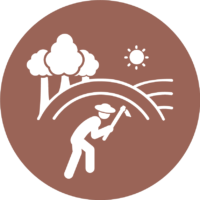The Value of Community-managed Agroforests and Second-growth Forests as Restoration Approaches
Souza, S. E. X. F., E. Vidal, G. F. Chagas, A. T. Elgar, and P. H. S. Brancalion. 2016. Ecological outcomes and livelihood benefits of community-managed agroforests and second growth forests in Southeast Brazil. Biotropica 48:868-881.
The Forest and Landscape Restoration movement has emerged as an approach to reconcile biodiversity conservation, ecosystem services provisioning and human well-being in degraded landscapes, but little is known so far about the potential of different reforestation methods to achieve these objectives. Sometimes, restoration is a mandatory activity that replace agro-pastoral land uses and, in spite of the ecological gains, do not bring direct benefits to local people. In other cases, local people obtain many benefits from land use and forest management, but at the expenses of the degradation of natural resources. Combining multiple objectives in the same restoration project is a critical challenge today, as trade-offs are inevitably present and win-win solutions are rare.
One alternative, middle way approach is to develop restoration schemes that allow local people to obtain direct benefits from restoration, both through harvesting forest products for their subsistence and for commercialization (ideally both). Agroforests have been widely used in the global tropics as an ecologically efficient production system in contexts where farmers do not have financial conditions to pay for external agricultural inputs and rely on a myriad of products for their wellbeing, rather on the commercialization of a single agricultural commodity produced in more intensive systems. Similarly, indigenous and traditional communities have heavily relied on native forests for obtaining most of the products they need for living, like medicines, construction material, and food. Both community-managed agroforests and second-growth forests could play a role as alternative restoration models to maximize the benefits for conservation and livelihoods, thus reducing the trade-offs that have prevented the expansion of restoration on private farms.
This study demonstrated the value of community-managed agroforests and second-growth forests as a restoration approach in the coastal Atlantic Forest of Brazil. Agroforests and, more remarkably, managed secondary forests, allowed the recovery of a well-developed forest structure, rich of native species − including five threatened species −, and supplied market valuable and culturally important plants, of an impressive variety of 231 native ethnospecies. These production systems included an emblematic threatened palm – Euterpe edulis – which have been overexploited in the region for palm heart production and has now been exploited by local farmers and communities for fruit pulp production, a sustainable alternative as the palm does not have to be cut to be used. The fruit pulp of this species has been used as an equivalent of the açaí (E. oleraceae), of the Amazon basin, and have allowed farmers to make their living from the conservation and restoration of E. edulis populations, which directly benefit the many frugivorous birds that feed on its fruits.
The PARTNERS Connection
This paper was published in a special issue of Biotropica that was organized by PARTNERS, with the aim of compiling a collection of high-level publications about the main challenges for large-scale restoration. This special issue was an important incentive for this paper, and the discussions authors had with other PARTNERS members during the workshops were essential for consolidating the idea of this work and presenting this Brazil’s case study for an international audience.





